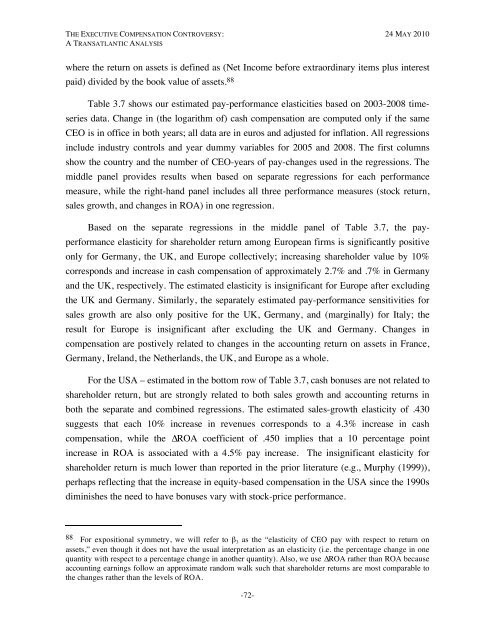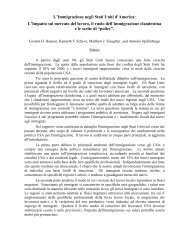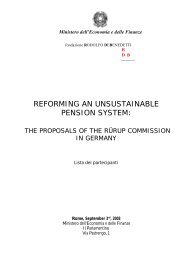The Executive Compensation Controversy - Fondazione Rodolfo ...
The Executive Compensation Controversy - Fondazione Rodolfo ...
The Executive Compensation Controversy - Fondazione Rodolfo ...
Create successful ePaper yourself
Turn your PDF publications into a flip-book with our unique Google optimized e-Paper software.
THE EXECUTIVE COMPENSATION CONTROVERSY: 24 MAY 2010A TRANSATLANTIC ANALYSISwhere the return on assets is defined as (Net Income before extraordinary items plus interestpaid) divided by the book value of assets. 88Table 3.7 shows our estimated pay-performance elasticities based on 2003-2008 timeseriesdata. Change in (the logarithm of) cash compensation are computed only if the sameCEO is in office in both years; all data are in euros and adjusted for inflation. All regressionsinclude industry controls and year dummy variables for 2005 and 2008. <strong>The</strong> first columnsshow the country and the number of CEO-years of pay-changes used in the regressions. <strong>The</strong>middle panel provides results when based on separate regressions for each performancemeasure, while the right-hand panel includes all three performance measures (stock return,sales growth, and changes in ROA) in one regression.Based on the separate regressions in the middle panel of Table 3.7, the payperformanceelasticity for shareholder return among European firms is significantly positiveonly for Germany, the UK, and Europe collectively; increasing shareholder value by 10%corresponds and increase in cash compensation of approximately 2.7% and .7% in Germanyand the UK, respectively. <strong>The</strong> estimated elasticity is insignificant for Europe after excludingthe UK and Germany. Similarly, the separately estimated pay-performance sensitivities forsales growth are also only positive for the UK, Germany, and (marginally) for Italy; theresult for Europe is insignificant after excluding the UK and Germany. Changes incompensation are postively related to changes in the accounting return on assets in France,Germany, Ireland, the Netherlands, the UK, and Europe as a whole.For the USA – estimated in the bottom row of Table 3.7, cash bonuses are not related toshareholder return, but are strongly related to both sales growth and accounting returns inboth the separate and combined regressions. <strong>The</strong> estimated sales-growth elasticity of .430suggests that each 10% increase in revenues corresponds to a 4.3% increase in cashcompensation, while the ∆ROA coefficient of .450 implies that a 10 percentage pointincrease in ROA is associated with a 4.5% pay increase. <strong>The</strong> insignificant elasticity forshareholder return is much lower than reported in the prior literature (e.g., Murphy (1999)),perhaps reflecting that the increase in equity-based compensation in the USA since the 1990sdiminishes the need to have bonuses vary with stock-price performance.88 For expositional symmetry, we will refer to β 3 as the “elasticity of CEO pay with respect to return onassets,” even though it does not have the usual interpretation as an elasticity (i.e. the percentage change in onequantity with respect to a percentage change in another quantity). Also, we use ∆ROA rather than ROA becauseaccounting earnings follow an approximate random walk such that shareholder returns are most comparable tothe changes rather than the levels of ROA.-72-









